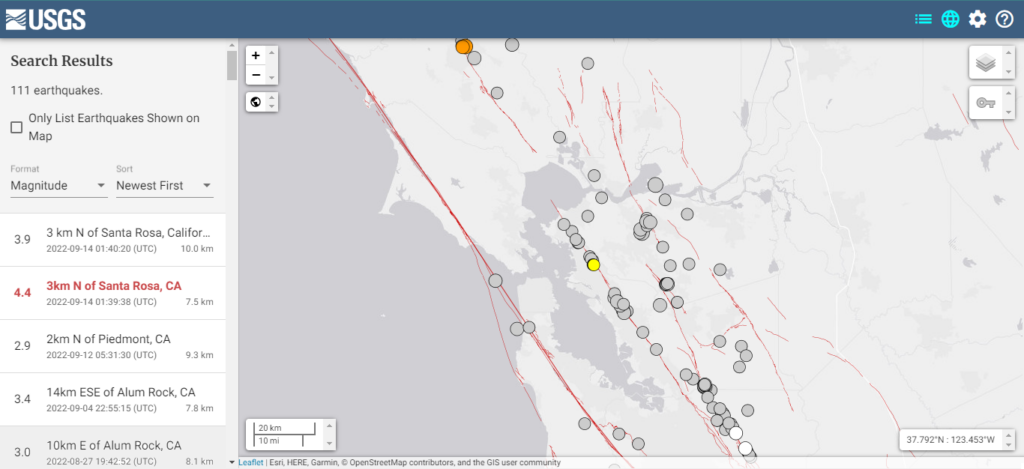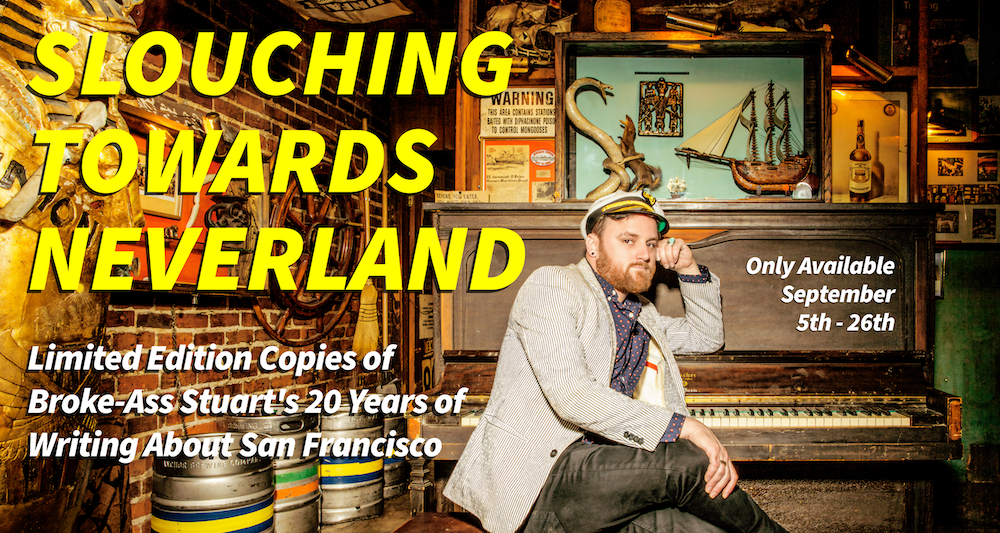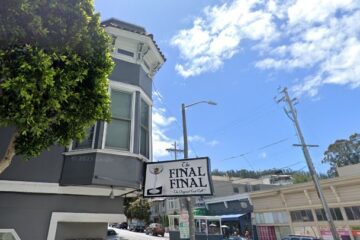Is The Bay Area’s “Earthquake Drought” Ending?

All Bay Area tremors above M2.5 since October 2019, when the region’s last sizable earthquake (M4.5) occurred. Tuesday night’s M4.4 is in orange; Sunday night’s M2.9 is in yellow.
Sunday night’s earthquake was unremarkable by California standards. For some, the M2.9 tremor was their very first seismic experience. A burp of the notorious Hayward Fault, it struck near the mouth of the Caldecott Tunnel directly beneath Highway 24, where it dams Lake Temescal. North Oakland’s Rockridge and Piedmont neighborhoods, along with most of Berkeley, reported feeling “a quick, sharp jolt.” While thrilling, an ordinary Bay Area earthquake never lasts in the public eye. A stronger shock in San Jose, hardly two weeks old, is already fading from memory.
On Tuesday night, it happened again. A M4.4 struck near Santa Rosa at 6:39 PM. The ostensible uptick in seismic activity across the Bay Area has some wondering, is our “earthquake drought” ending?
On Shaky Ground
Apart from a few hiccups here and there, the faults underpinning the Bay Area have been ominously still. Things weren’t always this way. Large earthquakes struck the Bay Area hard and often throughout the nineteenth century. In 1864, San Francisco’s oldest newspaper the Alta California described the ominous rise in seismic activity:
“Earthquakes are becoming a permanent institution in California. Scarcely a week passes without one or more shocks being felt; this season they seem to be more numerous and severe than usual.”
Ignoring an extra dozen or so temblors above M5.0, at least fourteen earthquakes M6.0 or higher throttled the region between 1838 and the Great Earthquake. That’s fourteen separate South Napa-sized events, all before 1906.
Since then, there have only been five.
Life Inside a Stress Shadow
Reactions to earthquakes are tame, unmoving, predictable—in exact opposition to earthquakes themselves. What if, like the vulnerable bridges spanning the bay, our standards aren’t up-to-code? California prospers in the shadow of its two most recent Big Ones. The first, a ~M7.9, ruptured most of the southern San Andreas in 1857, claiming only two SoCal settlers. Next came the legendary San Francisco Earthquake of 1906, which ruptured the San Andreas Fault’s northern half and killed over three thousand people.
In both respects, significant seismic stress had accumulated in the fault system, pushing their segments closer to the breaking point. When it finally goes, it’s because a little jolt hit the right depth at the right time. In 1906, less than a minute before the quake, a modest tremor emanated from the earthquake’s imminent hypocenter. Anyone awakened probably thought nothing of it. Another quiver of the Earth. It happens all the time.
These earthquakes were so powerful, they induced what seismologists call a stress shadow. In theory, it happens when a massive quake unleashes virtually all the stress stored on the fault. The plates however do not stop moving. Relaxed, the fault is free to resume storing stress for the next Big One. Seismicity is nil where the San Andreas ruptured in 1857 and 1906. It takes decades, even centuries for sufficient force to re-accrue. Solid rock stores a shocking supply of potential energy, but it too has limits.

The 1906 and 1857 ruptures appear in red; the active, creeping segment of the San Andreas in green. The southernmost segment, in black, hasn’t failed since the mid-1600s.
On The Rebound
It feels gauche to call it a drought when we’re already experiencing one in the traditional sense. Indeed, a dearth of earthquakes sounds like a good thing. A better word might be lapse, maybe lull. Regardless, it reflects the truth of our situation, that stress shadows are temporary.
Stress shadows are part of what seismologists call elastic rebound theory. As per the United States Geological Survey, “If a stretched rubber band gets broken or cut, elastic energy stored in the rubber band during the stretching will suddenly be released. Similarly, the crust of the earth can gradually store elastic stress that is released suddenly during an earthquake.”
You can find evidence of this crustal distortion in offset curbs and sidewalks, riven retaining walls and en echelon street cracks, inexplicable right-angle jogs in streams and dry riverbeds. The earth around a fault warps to accommodate the strain, digging bays, building mountains. Brackish water pooled in the downwarped crust between the San Andreas Fault and the Berkeley Hills. The Hills themselves, in fact a mini-mountain range, are a creation of the Hayward Fault.
Locked and Loaded

Of the seven major Bay Area faults, the Hayward Fault is the one to watch. Scientists determined an average interval of 140 years between earthquakes. It last ruptured violently in 1868.
The Hayward Fault is frequently named the state’s “most urbanized fault,” and the most dangerous. It undercuts the South Bay and Hetch-Hetchy Aqueducts, multiple shopping malls, suburban streets, lakes, ponds, freeway mazes, natural gas and sewage lines, city parks, driveways, railroad tracks, golf courses, grocery stores, a resort hotel, Memorial Stadium, the Oakland Zoo, the campuses of Contra Costa College, Ohlone College, Cal State: East Bay, UC Berkeley, a Boy Scouts of America camp, and the Berkeley Hills BART tunnel. According to the U.S. Geological Survey, the fault is set to go off “anytime now.”
That statement was issued in 2008.
If you’re waiting for the advent of seismic prediction, don’t hold your breath. Scientists account for stress shadows and rebound theory in their calculations of a given fault’s behavior, but that doesn’t make earthquakes predictable. “At this point,” says eminent seismologist Dr. Lucy Jones, “we have not been able to find anything different about how a magnitude one begins and how a magnitude seven begins. They seem to begin the same way.”
“For prediction to ever be possible,” says Dr. Jones, “there has to be information in the earth about how big an earthquake will be before it begins, and the data is looking like the magnitude is determined dynamically during the event.” The infinitely complex and constantly shifting geometry of a fault, combined with intractable tectonic force, makes prediction mathematically impossible. “Which means the earth does not have that information before it begins.”
Three Ways Your Lazy-A** Can Prepare Today
Prediction is not the answer. The necessary factors are simply not in place. Instead, the solution here is preparation. Whether or not the “earthquake drought” is ending, it will pay off to be prepared. Sure, you could buy one of those fancy earthquake kits, but Dr. Jones says that evacuation and go-bags are hurricane ideas. After an earthquake, you may have to hunker down in your home for a few days while the city restores electricity and running water. If your lazy ass can do these three things today, you’ll have a much better shot at living through tomorrow.
1. Get some goddamn food and water.
The average human needs between 2.7 and 3.7 litres of water per day. That’s one giant jug of Crystal Geyser every twenty-four hours. Authorities say to prepare for at least three days without any federal assistance. Do you have that much water stored at home?
Also: you will need to eat. Just don’t buy anything you wouldn’t eat in a non-emergency. Put that creamed corn back where you found it. Crackers and canned fruit are a surefire bet.
2. Get a goddamn flashlight.
Earthquakes can strike anytime, meaning there’s a fifty-fifty shot it’ll happen in the dark. Keep a flashlight and batteries somewhere you can reach easily and quickly. How are you going to safely navigate the debris in your apartment if you can’t see shit?
3. Put some goddamn shoes and socks under your bed.
The most common post-quake injuries are lacerations to bare feet. Unless you’re some kind of freak, you don’t go to bed with shoes on. That’s why you should take that old pair of sneakers, stuff a pair of socks inside, and tie them to the bedpost underneath the frame so they don’t go walking off during the commotion.
You can’t predict an earthquake, but you can pre-empt your own helplessness in the wake of one.
LIKE THIS POST? THEN YOU’LL LOVE STUART’S NEW ZINE!
Get this limited edition, hand signed zine covering 20 years of Stuart’s writings on San Francisco! Learn more right here.











